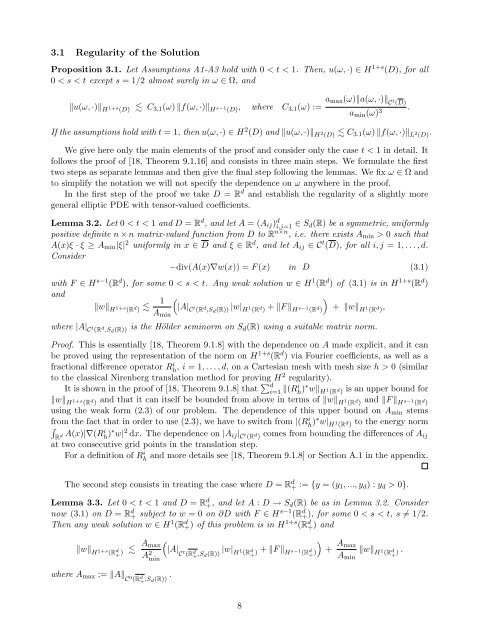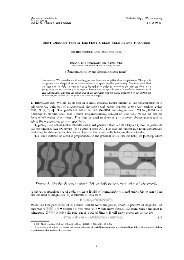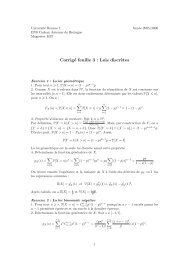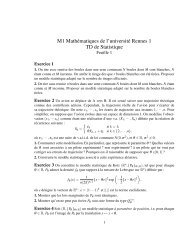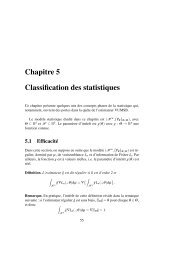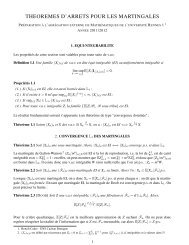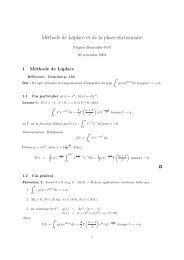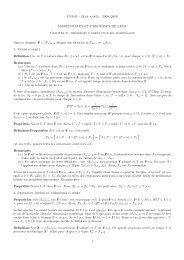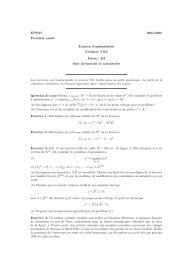Bath Institute For Complex Systems - ENS de Cachan - Antenne de ...
Bath Institute For Complex Systems - ENS de Cachan - Antenne de ...
Bath Institute For Complex Systems - ENS de Cachan - Antenne de ...
Create successful ePaper yourself
Turn your PDF publications into a flip-book with our unique Google optimized e-Paper software.
3.1 Regularity of the SolutionProposition 3.1. Let Assumptions A1-A3 hold with 0 < t < 1. Then, u(ω, ·) ∈ H 1+s (D), for all0 < s < t except s = 1/2 almost surely in ω ∈ Ω, and‖u(ω, ·)‖ H 1+s (D) C 3.1 (ω) ‖f(ω, ·)‖ H s−1 (D), where C 3.1 (ω) := a max(ω)‖a(ω, ·)‖ C t (D)a min (ω) 3 .If the assumptions hold with t = 1, then u(ω, ·) ∈ H 2 (D) and ‖u(ω, ·)‖ H 2 (D) C 3.1 (ω) ‖f(ω, ·)‖ L 2 (D).We give here only the main elements of the proof and consi<strong>de</strong>r only the case t < 1 in <strong>de</strong>tail. Itfollows the proof of [18, Theorem 9.1.16] and consists in three main steps. We formulate the firsttwo steps as separate lemmas and then give the final step following the lemmas. We fix ω ∈ Ω andto simplify the notation we will not specify the <strong>de</strong>pen<strong>de</strong>nce on ω anywhere in the proof.In the first step of the proof we take D = R d and establish the regularity of a slightly moregeneral elliptic PDE with tensor-valued coefficients.Lemma 3.2. Let 0 < t < 1 and D = R d , and let A = (A ij ) d i,j=1 ∈ S d(R) be a symmetric, uniformlypositive <strong>de</strong>finite n × n matrix-valued function from D to R n×n , i.e. there exists A min > 0 such thatA(x)ξ · ξ ≥ A min |ξ| 2 uniformly in x ∈ D and ξ ∈ R d , and let A ij ∈ C t (D), for all i, j = 1, . . . , d.Consi<strong>de</strong>r−div(A(x)∇w(x)) = F (x) in D (3.1)with F ∈ H s−1 (R d ), for some 0 < s < t. Any weak solution w ∈ H 1 (R d ) of (3.1) is in H 1+s (R d )and‖w‖ H 1+s (R d ) 1 ()|A|A C t (R d ,S d (R)) |w| H 1 (R d ) + ‖F ‖ H s−1 (R d ) + ‖w‖ H 1 (R d ),minwhere |A| C t (R d ,S d (R)) is the Höl<strong>de</strong>r seminorm on S d (R) using a suitable matrix norm.Proof. This is essentially [18, Theorem 9.1.8] with the <strong>de</strong>pen<strong>de</strong>nce on A ma<strong>de</strong> explicit, and it canbe proved using the representation of the norm on H 1+s (R d ) via Fourier coefficients, as well as afractional difference operator Rh i , i = 1, . . . , d, on a Cartesian mesh with mesh size h > 0 (similarto the classical Nirenberg translation method for proving H 2 regularity).It is shown in the proof of [18, Theorem 9.1.8] that ∑ di=1 ‖(Ri h )∗ w‖ H 1 (R d ) is an upper bound for‖w‖ H 1+s (R d ) and that it can itself be boun<strong>de</strong>d from above in terms of ‖w‖ H 1 (R d ) and ‖F ‖ H s−1 (R d )using the weak form (2.3) of our problem. The <strong>de</strong>pen<strong>de</strong>nce of this upper bound on A min stemsfrom the fact that in or<strong>de</strong>r to use (2.3), we have to switch from |(Rh i )∗ w| H 1 (R d ) to the energy norm∫RA(x)|∇(R i d h )∗ w| 2 dx. The <strong>de</strong>pen<strong>de</strong>nce on |A ij | C t (R d ) comes from bounding the differences of A ijat two consecutive grid points in the translation step.<strong>For</strong> a <strong>de</strong>finition of Rh i and more <strong>de</strong>tails see [18, Theorem 9.1.8] or Section A.1 in the appendix.The second step consists in treating the case where D = R d + := {y = (y 1 , ..., y d ) : y d > 0}.Lemma 3.3. Let 0 < t < 1 and D = R d +, and let A : D → S d (R) be as in Lemma 3.2. Consi<strong>de</strong>rnow (3.1) on D = R d + subject to w = 0 on ∂D with F ∈ H s−1 (R d +), for some 0 < s < t, s ≠ 1/2.Then any weak solution w ∈ H 1 (R d +) of this problem is in H 1+s (R d +) and‖w‖ H 1+s (R d + ) A )max(|A|A 2 C t (R d +min,S d(R)) |w| H 1 (R d + ) + ‖F ‖ H s−1 (R d + ) + A max‖w‖A H 1 (R d min+ ) .where A max := ‖A‖ C 0 (R d + ,S d(R)) . 8


